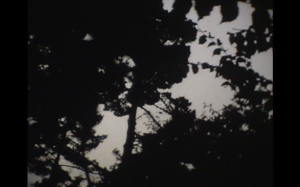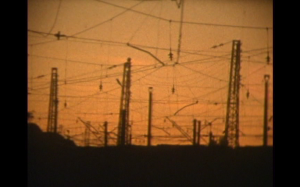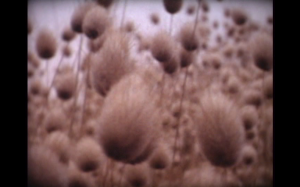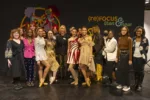It is not uncommon for the current generation of experimental and noise musicians to incorporate film into their performances. Oftentimes, the moving images feel arbitrarily chosen, as if selected merely to give the audience something to look at during performances in which the artists remain static. In rare instances, however, the relationship of abstract music to the film images with which it is paired is a symbiotic one, each informing and complementing the other. Such is the case on “Within Mirrors,” a DVD collection of seven short films, originally released between 2005 and 2008, by Paul Clipson featuring music by Jefre Cantu-Ledesma. The result is a stunning example of how successful a collaboration across mediums can be.
Kaleidoscopic films of urban, natural and industrial environments
Clipson has been screening his films, frequently with live musical accompaniment, in art galleries, museums, and independent venues around the world for over a decade, in addition to designing multi-channel video installation pieces. His primary medium is heavily manipulated Super 8. Images are overexposed and superimposed upon one another. His films often rapidly cut from one image to the next and the filmmaker relies heavily on fading many superimposed images in and out simultaneously, creating a highly dynamic series of ever-shifting collages.
Sprawling kaleidoscopic explorations of urban, industrial, and natural environments, Clipson’s films are meditations on architecture, unexpected or unintended geometries, textures, and patterns found all around us, and on the ways in which human environments and natural environments collide. His images move from dreamy, dissolving landscapes, to frantic, explosive masses of shifting light and color, and from quiet, chiaroscuro-tinged explorations of darkness and negative space, to exuberant journeys through dense thickets of foliage at an insect-eye level, road trips down bleary, rain slicked highways, and bird’s-eye views of rippling, sun-drenched bodies of water.
These films are most successful when blurring the line between the abstract and the concrete; when we realize that an undulating chain of red and yellow dots is actually cars snaking down a highway, when chain-link fences, the veins on leaves, or the halos around light bulbs are transformed into inscrutable geometric patterns, or when a tree canopy dissolves into a Rorschach ink blot, we are invited to discover new, often startlingly beautiful ways of gazing at the mundane.

Influenced by the American Avant-Garde
In many ways, Clipson’s films are rooted in the traditions of American Avant-Garde film. Appearing throughout the works collected here, his warped, psychedelic cityscapes are reminiscent of Stan Brakhage, while his more naturalistic, insect-level journey through wind-whipped grasses in The Lights & Perfections recall moments from Jonas Meekas’s As I Was Moving Ahead Occasionally I Saw Brief Glimpses of Beauty. Other references abound, however.
The frequent vibrant abstractions of cityscapes into a series of colored nodes in a geometric plane seem almost like a Mondrian set into explosive motion.
The industrial yards in Sphinx on the Seine, hypersaturated with color, could be an homage to Rossellini’s chilling Deserto Rosso. The soft color palette and nostalgic shots of fading architecture on Corridors calls to mind Chantal Akerman’s News from Home, while the black-and-white ruminations on the geometry of scaffolding and building frames in the same may have been inspired by similar images in Yasujiro Ozu’s pioneering use of pillow shots in his many films. Meanwhile, Clipson’s textural, expansive shots of water might remind the viewer of a Vija Celmin painting, while his fog-enshrouded meditations on landscape evoke Hiroshi Sugimoto’s more abstract ocean photographs.

Texture, repetition and submerged melody in the music
One key element that sets these films apart is the accompanying music by Jefre Cantu-Ledesma. Cantu-Ledesma, well regarded for over a decade by fans of experimental, noise, and drone music both for co-founding the Root Strata record label and for his work in numerous projects including Tarentel, The Alps, Moholy-Nagy, and The Holy See, was one of the first sound artists to collaborate with Clipson. As a solo artist, especially in the examples gathered for this collection, Cantu-Ledesma is deeply interested with texture, repetition, and the blurring and abstraction of elements we expect in music – melody, for example – often keeping them submerged and near-obliterated but not altogether lost. Just as Clipson’s abstract images resolve into concrete forms, so too does Cantu-Ledesma at times unearth for the listener some lost fragment of song beneath all his sonic wash and decay.
Both artists are also highly interested in texture; Cantu-Ledesma frequently draws from the aural palette of early 90s shoegaze, churning out vast, blasted guitarscapes and angular, aggressive assaults, rich with static and reverb.
At other times, Cantu-Ledesma creates soundscapes that are redolent in aural fog, with ghostly pulsations of static and low-end rumble slowly seething, unfurling, and decaying all at once. Cantu-Ledesma draws from an array of influences, referencing everything from droning Indian Ragas to 60s psychedelia. The Phantom Harp, for example, is a dreamy, glacial piece for treated autoharp, a kind of post-New Age drone that is equal parts hypnotic and mysterious. Two Suns, by contrast, sounds far more primal. Built upon a heavily distorted vocal drone and featuring jangling percussion, it transforms the human voice into a blurry, thrumming soundscape that perfectly accompanies Clipson’s propulsive, grainy images. Corridors, meanwhile, is much denser, with ferocious tonal layers butting up against glimmering, ambient movements. Throughout the collection, whispers of static, pulsing harmonics, and grinding post-industrial clatter meld into and spill out of one another.

Cantu-Ledesma’s work, much like Clipson’s, is stylistically diverse, and simultaneously capable of evoking a multitude of influences and inspirations while still retaining, at its core, a truly original aesthetic. Like many of Clipson’s images, Cantu-Ledesma’s sounds are impressionistic; both not only allow, but actively encourage, the audience to get lost in sprawling landscapes of color, light, and noise, or shadowy ambient fog.
Although both the film and music stand on their own merits, taken together they create an entirely new whole. Rather than both elements merely existing side-by-side – a common affliction in collaborations across media – the two complement one another beautifully. Both artists are fascinated with the interplay of dark and light, with pastiche, with layers, and with exploring texture, angularity, and repetition. In many ways, it feels as if Cantu-Ledesma is scoring Clipson’s films as much as Clipson is creating a visualization of Cantu-Ledesma’s music. For collaborations of this kind, there is perhaps no higher praise.
The films/sound compositions on Within Mirrors are:
- Sphinx on the Seine (8:29)
- Two Suns (23:50)
- Constellations (7:23)
- The Lights & Perfections (10:42)
- Corridors (25:21)
- The Phantom Harp (20:36)
- Within Mirrors (21:15)
Within Mirrors was released by the record label Students of Decay. It is available for purchase from Experimedia.









